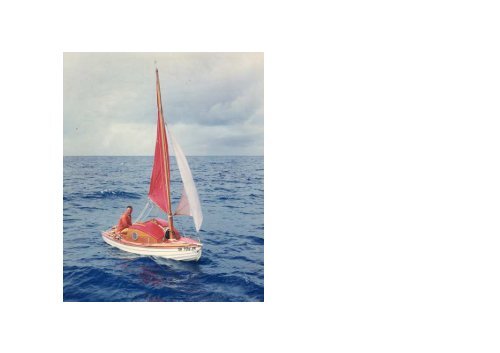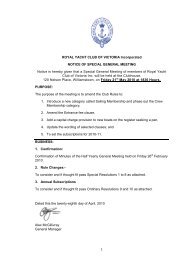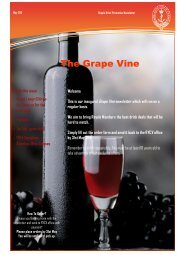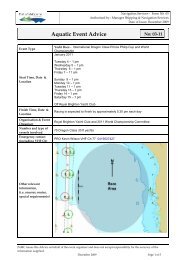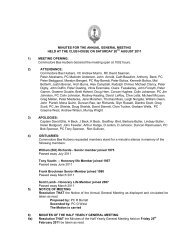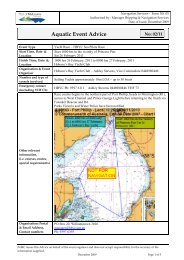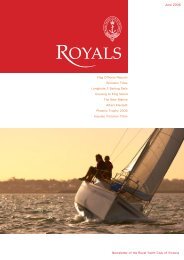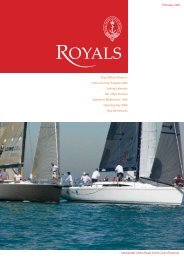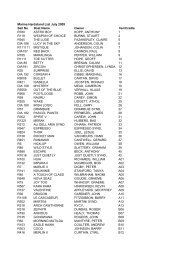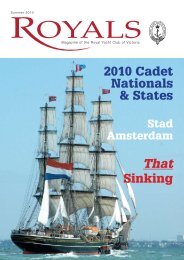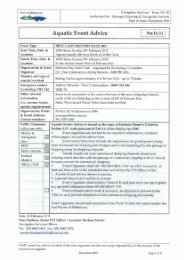Tinkerbelle - Robert Manry
Tinkerbelle - Robert Manry
Tinkerbelle - Robert Manry
You also want an ePaper? Increase the reach of your titles
YUMPU automatically turns print PDFs into web optimized ePapers that Google loves.
TINKERBELLE<br />
The ROBERT MANRY PROJECT<br />
The Man – Remembering <strong>Robert</strong> <strong>Manry</strong><br />
Life of a Dream – A few biographical notes on the life of Bob <strong>Manry</strong>…<br />
<strong>Robert</strong> Neal <strong>Manry</strong> was born 2 June 1918, high in the Himalayas at Landour, India. He was the first of four children of Dr. James C.<br />
and Margaret <strong>Manry</strong>, and was soon followed by brother John and sisters Dorothy and Louise.<br />
The family lived most of the year in Allahabad, Uttar Pradesh, where his father, a Presbyterian missionary, taught philosophy at<br />
Ewing College.<br />
His earliest sailing adventures took place on the nearby Jumna River. He was an active child, and early on, showed an interest in many<br />
things, including animals, adventure and the arts. While at high school, he helped organize the Drama Club. One early role was as a<br />
pirate in “Treasure Island” where he appeared with a parrot on his shoulder. Although he apparently had never tried to teach the bird<br />
to speak, in the midst of a scene, the parrot began calling out, “<strong>Robert</strong> <strong>Manry</strong>! <strong>Robert</strong> <strong>Manry</strong>!”<br />
In 1936 he left India to attend university in the United States, first stopping in Guangzhou (Canton), China, where he spent a semester<br />
at Lingnan University.<br />
He departed China on 14 July 1937, the day before the Japanese attack at the Marco Polo Bridge near Beijing. That autumn he<br />
enrolled at Antioch College in Yellow Springs, Ohio.<br />
During World War 2, <strong>Robert</strong> initially refused conscription, as a Conscientious Objector, and was jailed. Eventually he did serve, as a<br />
photographer, with the U.S. Army in Europe.<br />
He returned to Antioch College after the war, and received a degree in Political Science in 1948. According to his daughter, Robin, he<br />
was briefly married after graduating from Antioch.
He worked as a reporter for several newspapers in Ohio and Pennsylvania, and married Virginia Place, of Pittsburgh, in 1950. They<br />
moved to Cleveland in 1953 when he joined the staff of the Plain Dealer as a copy editor. Their daughter Robin was born in 1952 and<br />
son Douglas in 1954.<br />
He purchased <strong>Tinkerbelle</strong> in 1958, made repairs and sailed her for the first time in 1959. During the following years, “Tink” was a<br />
constant companion and center of attention on family vacations.<br />
<strong>Robert</strong> made his historic voyage across the Atlantic in 1965. He returned to Cleveland, but not to his job at the Plain Dealer. Rumors<br />
persisted that his employers never forgave him for being “scooped” by the competition, but it seems evident that he was merely taking<br />
advantage of his newfound opportunities. He enjoyed a successful career on the lecture circuit and spent several months completing a<br />
book about his adventure. In 1966, <strong>Tinkerbelle</strong>, published by Harper and Row, became an immediate bestseller.<br />
In 1967, <strong>Robert</strong> began an odyssey around the eastern United States in a new boat, Curlew. His wife, children, and the family<br />
menagerie joined him on this voyage.<br />
On 3 May 1969 Virginia died in a one-car accident near Youngstown, Ohio, while returning from a visit to her ailing mother in<br />
Pittsburgh, who died the following day.<br />
In October 1970 <strong>Manry</strong> married Jean Flaherty of Pittsburgh.<br />
On 21 February 1971 <strong>Robert</strong> <strong>Manry</strong> died of a massive heart attack after dinner with friends in Union City, Pennsylvania. He was 52.<br />
He is buried in Mt. Lebanon Cemetery in Mt. Lebanon, Pennsylvania.<br />
The Voyages of <strong>Robert</strong> <strong>Manry</strong><br />
Wet Feet<br />
From his first humble (and as he told the story, humbling) outings on the Jumna River in India, <strong>Robert</strong> <strong>Manry</strong> pursued the adventure<br />
of sailing throughout his life.
[More Wet Feet Coming Soon – Childhood Sailing Photos]<br />
Rebirth of a Dream<br />
<strong>Robert</strong> and Virginia settled down in Cleveland, Ohio, when he took a job as copy editor at the Cleveland Plain Dealer. The Plain<br />
Dealer was (as it still is) a morning newspaper, so his editorial shift began in the evening. It became <strong>Robert</strong>’s habit to read the next<br />
day’s classified ads when he took his lunch break around ten P.M. Eventually, in 1958 he spotted the listing for the tiny wooden boat<br />
that became <strong>Tinkerbelle</strong>, took full advantage of his head start, contacted the owner, and purchased the boat the following morning for<br />
$160.<br />
After performing essential repairs, <strong>Tinkerbelle</strong> became the focal point for family vacations. Several years of camping/sailing trips<br />
followed, with the family hauling <strong>Tinkerbelle</strong> on her trailer to various lakes in the region. Pymatuning Lake was a favorite spot.<br />
In the early years, <strong>Tinkerbelle</strong> had no cabin or deck, and she was rigged with an awning to serve as a tent at night.<br />
[More Coming Soon]<br />
Thunder Bay – First Voyage in <strong>Tinkerbelle</strong> – 1964<br />
By the early sixties, <strong>Robert</strong> was clearly interested in venturing further afield, and he added a cabin to his petite ship. During the<br />
summer of 1964, at the same time he began mentioning a possible trans-Atlantic crossing on a friend’s yacht, <strong>Robert</strong> made his own<br />
voyage across Lake Erie to Thunder Bay in Ontario, Canada. His 10-year old son Douglas joined him on Tink’s first grand cruise.<br />
Together, they sailed 200 miles over the course of a week, putting in to shore and anchoring each night.<br />
[More Thunder Bay Coming Soon]<br />
Falmouth to Falmouth – Trans-Atlantic Passage – 1965<br />
The cruise to Thunder Bay convinced <strong>Robert</strong> of the seaworthiness of little <strong>Tinkerbelle</strong>, and upon his return to Cleveland, he secretly<br />
committed to his plan of sailing her across the Atlantic. The following June he departed from Cape Cod, on a voyage that would<br />
amaze the world
CLEVELAND.COM<br />
Cleveland newsman sailed tiny boat named '<strong>Tinkerbelle</strong>' solo across<br />
Atlantic 45 years ago<br />
Published: Wednesday, August 18, 2010, 4:36 AM Updated: Wednesday, August 18,<br />
2010, 8:58 PM<br />
http://www.cleveland.com/plain-dealerlibrary/index.ssf/2010/08/cleveland_newsman_sails_tiny_boat_named_tinkerbelle_solo_across_the_atlantic_45_years_ago.html<br />
More than 50,000 people welcomed The Plain Dealer's <strong>Robert</strong> <strong>Manry</strong> in England<br />
CLEVELAND, Ohio -- In August 1965, <strong>Robert</strong> <strong>Manry</strong> arrived in Falmouth, England weeks after departing by sailboat from<br />
Falmouth, Mass., on June 1. His 78-day voyage captured the imaginations of people on two continents and created a media<br />
frenzy in America and Britain.<br />
<strong>Manry</strong>'s trans-Atlantic, nonstop sailing feat was made even bigger because of the size of his boat: just 13½ feet. He had<br />
traveled 3,200 miles in the tiny boat he named "<strong>Tinkerbelle</strong>."<br />
<strong>Manry</strong> was one of our own. That is, he was both a resident of Northeast Ohio -- Willowick -- and a copy editor at The Plain<br />
Dealer.<br />
Plain Dealer editors believed the voyage merited several days of front-page coverage. Photo editor William Ashbolt and reporter<br />
Russell Kane were dispatched to cover <strong>Manry</strong>'s arrival in Falmouth, England. The paper was able to transmit photographs<br />
across the pond with brand new equipment, considered state-of-the-art for its time.<br />
An image of <strong>Manry</strong> inspired a sculpture, while his boat inspired models made not only of wood, but also fruit, marzipan, and<br />
jewels.
By one account, the boat he used was already 37 years old when it crossed the ocean. In his book, <strong>Tinkerbelle</strong>, <strong>Manry</strong> describes<br />
the details of reconditioning the small vessel in the late 1950s.<br />
According to a Plain Dealer article by Martin T. Ranta, <strong>Manry</strong> was born in India and was comfortably sailing solo while still a<br />
child. But in 1965, <strong>Manry</strong>'s original plan was not to sail solo across the Atlantic. A friend who was to accompany him backed out<br />
of the adventure, according to Ranta's story.<br />
<strong>Manry</strong>'s wife, Virginia, appeared ever-supportive of her husband's adventure. Publications ran photos of their reunion kiss just<br />
moments before <strong>Manry</strong> sailed into Falmouth, England, finishing his journey.<br />
She wrote about the event in a Plain Dealer story. It began: "I had the biggest thrill of my life yesterday when I kissed my<br />
husband in the middle of the ocean. It wasn't really the middle, but we were out of sight of land ..."<br />
Epilogue:<br />
Although a resolution was introduced suggesting that <strong>Tinkerbelle</strong> be displayed at the Smithsonian Institution in Washington,<br />
D.C., <strong>Tinkerbelle</strong> remains in the area. The boat was preserved and can be seen at Western Reserve Historic Society.<br />
Virginia died in 1969, in an auto accident on the Ohio Turnpike. <strong>Robert</strong> <strong>Manry</strong> passed away in 1971 of a heart attack.<br />
<strong>Manry</strong>'s journey and his book, <strong>Tinkerbelle</strong> -- dedicated to Virginia, and his children, Robin and Douglas -- continued to<br />
influence sailors well after 1965.<br />
One follower, Steven Callahan, had to abort his solo attempt to cross the Atlantic in 1982. In his book, Adrift, he described<br />
how <strong>Manry</strong>'s book inspired his attempt.<br />
Another sailor and film editor, Steve Wystrach, is keeping <strong>Manry</strong>'s philosophy of life alive for all those who believe in pursuing<br />
their passions. Wystrach created a multimedia website, The <strong>Robert</strong> <strong>Manry</strong> Project, dedicated to keeping <strong>Manry</strong>'s story<br />
accessible for all who dream and who dare. Wystrach has spent considerable resources gathering <strong>Manry</strong>'s film footage, photos,<br />
correspondence and memoirs. He maintains an archive that makes clear his great respect for <strong>Manry</strong>.
FAMOUS SMALL BOATS<br />
http://www.microcruising.com/famoussmallboats.htm<br />
Year Length Boat Name Captain Description<br />
1789 23' William Bligh<br />
1866 26'<br />
Red, White and<br />
Blue<br />
1870 20' City of Ragua<br />
1875 12'<br />
Centennial<br />
Republic<br />
J.M. Hudson<br />
J.C. Buckley & Nicholas<br />
Primoraz<br />
N.H. Bishop<br />
1876 20' Centennial Alfred Johnson<br />
1877 19'7" New Bedford Thomas & Joanna Crapo<br />
1878 19' Nautilus William & Asa Andrews<br />
1880-<br />
1881<br />
16' Little Western<br />
Fredrick Norman &<br />
George P. Thomas<br />
Set adrift near Timor after the famous "Mutiny of the Bounty", Captain Bligh and a crew of 18 loyal<br />
men survived a seven-week, 3,600-mile voyage in the cramped boat to reach the island of Timor.<br />
Certainly this ranks as one of the great small boat passages of all time.<br />
Two Americans, J.M. Hudson and F.E. Fitch, crossed the Atlantic in a special galvanized metal<br />
lifeboat in 37 days from New York to England. This 2 1/2 ton vessel is the smallest boat to cross the<br />
Atlantic up to this date. It went on to sail to France to be displayed at the Paris Exhibition.<br />
This American and Australian (respectively) sailed a converted ship's lifeboat from Cork, Ireland to<br />
Boston, Massachusetts. The trip lasted 84 days and is considered the first small boat Atlantic<br />
crossing East to West, as well as the first two man crossing in either direction. Noted in several books<br />
but best account is in Humphrey Barton's "Atlantic Adventurers."<br />
Pittsburgh to Gulf of Mexico via the Ohio and Mississippi rivers in a Sneak-box.<br />
First person to cross the Atlantic solo West to East. This Grand Banks fisherman sailed his gaffrigged<br />
dory from Gloucester, New Brunswick to Albertcastle, England. His boat is now on display in<br />
the Cape Ann Historical Society museum in Gloucester, MA.<br />
This couple departed New Bedford, Massachusetts in their ketch rigged dory and arrived in Penzance<br />
England 49 days later. Originally Thomas had planned to go alone, but his wife insisted on coming.<br />
The voyage is noted in various sources including Thomas Crapo's book, "Strange But True: Life and<br />
Adventures of Captain Thomas Crapo and Wife," as well as in Jean Merriens' "Loney Voyagers."<br />
These two brothers sailed from Beverly, Massachusetts to Cornwall England in their two masted<br />
lateen rigged center boarder.<br />
These two Brits performed the first double crossing of the Atlantic. They departed Gloucester,<br />
Massachusetts on June 12, 1880 before a crowd of 30,000 and arrived in Cowes, England on July 28,<br />
1880. They stayed in England for a year and then set out on their return trip on June 15, 1881. After a<br />
difficult journey they arrived back in America after 65 days at sea. They not only beat the Andrew<br />
brother record for the smallest boat to make the crossing but also bettered the Andrews West to East<br />
crossing record by three days.<br />
1881 18' City of Bath Ivar Olsen & John These two sailed in their dory from Newfoundland to Falmouth, England. This trip is noted in
1882-<br />
1883<br />
Trynor<br />
19' Pacific Bernard Gilboy<br />
Humprey Barton's, "Atlantic Adventurers."<br />
He almost complete a trip from San Francisco to Australia aboard his 19' double-ended schooner.<br />
Unfortunately, his stores ran out after 6500 miles and 164 days. He was picked up at sea only 160<br />
miles from Australia. The story is told in a log book printed as "A Voyage of Pleasure."<br />
1888 12' 9" Dark Secret William Albert Andrews Failed attempt at crossing the Atlantic, but succeeded later on in 1892.<br />
1891 15' Sea Serpent Josiah W. Lawlor<br />
1892 14'6" Sapolio William Albert Andrews<br />
1903 17' America Howard Blackburn<br />
1903 20' Colombia II Ludwig Eisenbraun<br />
1904 18' Vraad Ole (Abe)Brude<br />
1914-<br />
1916<br />
22' James Caird Sir Ernest Shackleton<br />
1926 20' Teresia Fava<br />
1928 18' Aga Paul Muller<br />
1931-<br />
1933<br />
19' Elain<br />
Paul Sproge (aka, Fred<br />
Rebell)<br />
Took part in a race from Boston to England against William Andrews in his 15' boat,<br />
Mermaid. Andrews's boat capsized several times, and he was rescued 600 miles East of Europe.<br />
Despite capsizing several times himself, Lawlor sailed on to reach Lizard Point, England in 45 days.<br />
Lawlor was eventually lost at sea during another race against Andrew. He and his 14'6"<br />
boat "Christopher Columbus" were never found.<br />
Crossed the Atlantic from New Jersey to Portugal, and his record for the smallest boat crossing stood<br />
for 73 years. Andrews tried again in 1898 to cross the Atlantic in the 13' "Phantom Ship" but failed<br />
after 27 days at sea. The boat was then shortened in 1899 to 12' and renamed the "Doree," but he<br />
failed again after 3 weeks. In the end, Andrews was lost at sea while attempting another Atlantic<br />
crossing with his new bride in 1901 aboard the "Flying Dutchman."<br />
He attempted to cross the Atlantic from West to East in his tiny dory, but he capsized 165 miles East<br />
of Cape Sable. After righting the boat, he returned to port because his stores were ruined. What is so<br />
remarkable is that Blackburn was fingerless and that he had already crossed the Atlantic solo in both<br />
his 30' sailboat GREAT WESTERN (1899) and in the 25' sloop GREAT REPUBLIC (1901).<br />
He sailed from Boston via Nova Scotia to Madeira, arriving in 56 days, before continuing on<br />
to Gibraltar and Marseilles, France according to the book "Lonely Voyagers."<br />
This gaff rigged steel lifeboat was sailed with a crew of three from Norway to Boston in 162 days. It<br />
was reported to be "shaped like an English Walnut."<br />
Shackleton and five other crew members made an epic 800 mile voyage to South Georgia Island after<br />
their failed Antarctic expedition.<br />
This Italian sailed his home-built 20' cutter from Naples to Newfoundland. The boat was completely<br />
decked over except for a center cockpit. What is remarkable is that he had no legs, having lost them<br />
during WWI when he was a steamer commander.<br />
This German sailed his lugger from Hamburg to Santa Cruz and then on to the Bahamas, arriving in<br />
67 days. After visiting Miami his trip ended in South Carolina when his boat caught fire.<br />
He sailed across the Pacific in this small center boarder from Australia to San Pedro, California using<br />
70 year old charts.
1939 13'9" Harry Young<br />
1947-<br />
1948<br />
He sailed in his self-built undecked sloop from New York to the Azores in 39 days. His trip is noted in<br />
the "Big Book of Sailing" by Frank Grube and Gerhard Richter<br />
20' Inga Friedrich Brusgatis Sailed from Sweden to Venezuela, accompanied first by a friend and then his wife Yvonne.<br />
1948 16' Berlin Paul Muller<br />
1949 20' Nova Espero<br />
1951 20' Nova Espero<br />
Stanley Smith<br />
Colin Smith<br />
Stanley Smith<br />
Charles Violet<br />
(See 1928) Sailing in company with his 18 year old daughter, Muller was headed to South American<br />
from his home in Germany. On the way, though, he died and his daughter landed safely in Africa.<br />
Sailed from Halifax, Nova Scotia to England and written about in their book, "Smiths at Sea." An<br />
upturned dinghy served as a cabin.<br />
The second trip was in 1951 from Dartmouth UK to New York (via the Azores and Newfoundland)..<br />
For this trip she had had a cabin built and was yawl rigged. The trip took about 18 weeks, and they<br />
wrote a book about the trip called “The Wind Calls the Tune”. Charles Violet subsequently sailed the<br />
boat through the canals of France and around the Mediterranean (“Nova Espero’s Third Voyage).<br />
1952 19' Sopranino Patrick Ellam Patrick Ellam and Colin Mudie crossed the Atlantic East to West.<br />
1952 15' L'Heretique Dr. Alain Bombard<br />
1952-<br />
1959<br />
1955 18'<br />
1959-<br />
1960<br />
1960-<br />
1961<br />
Crossed from the Canary Islands to the West Indies in a rubber raft, living solely off the ocean for 65<br />
days.<br />
20' Trekka John Guzzwell Sailed around the world. The book, "Trekka Around The World," is a must read.<br />
Hippocampe<br />
(Sea Horse)<br />
Jean Lacombe<br />
20' Craig Dayton J. Lalonde<br />
20' Ganga Devi Capt. John Alexander,<br />
This French photographer sailed from Toulon, France and arrived in Puerto Rico in 68 days aboard his<br />
small Bermudian cutter. He then continued on to Atlantic City with his final destination being New<br />
York City. Later on his sailed in the first single-handed transatlantic race in his 21', "Cape Horn."<br />
This 35 year old American sailed from Los Angeles to Australia. The voyage was reported in the<br />
London Times on May 27, 1960.<br />
John along with Lt. Adrian Corkill and radio mechanic Hugh Burt sailed 9000 miles from Hong Kong<br />
to Falmouth, England according to the July 10, 1961 issue of the London Times.<br />
1962 19'1" Mermaid Kenichi Horie Solo-sailed across the Pacific from Japan to California.<br />
1963-<br />
2005<br />
16' Shoal Waters A.C. Stock<br />
1963- 16' Wanderer Margaret and Frank Dye<br />
60,000 miles of microcrusing in the Thames Estuary, and still going strong! Visit his website at<br />
http://shoal-waters.moonfruit.com/<br />
Their books "Ocean Crossing Wayfarer, Dinghy Cruising, The Enjoyment of Wandering Afloat and<br />
Sailing to the Edge of Fear" tell of their many adventures aboard their Wayfarer dinghy, W48.<br />
Probably the most famous trip taken in "Wanderer" was when Frank sailed 650 miles from Scotland<br />
to Iceland in 1963.<br />
1965 20' Island Girl John Letcher, Jr. Sailed from Honolulu to Sitka, Alaska in 44 days. See Yachting Magazine- June 1966 page
1965 13'6" <strong>Tinkerbelle</strong> <strong>Robert</strong> <strong>Manry</strong><br />
1965 8' Bathtub East to West Atlantic crossing.<br />
1965 24' Dove Robin Lee Graham<br />
1966 20' Thumbelina Kenneth Weis<br />
1966 12' Nonoalca Bill Verity<br />
1967 16' Korassa II Ikau Kashima<br />
67, "Single handed Sailing" by Richard Henderson, and "Self-Steering for Sailing Craft" by John<br />
Letcher Jr.<br />
Crossed the Atlantic from Falmouth, Massachusetts to Falmouth, England. Read the author's book,<br />
"<strong>Tinkerbelle</strong>" or see the boat at The Western Reserve Historical Society (Museum) in Cleveland,<br />
Ohio.<br />
Youngest person the sail around the world at the time, age 16-21. Later on Tania Aebi completed her<br />
circumnavigation at the age of 20 in her 26 foot boat Varuna from 1985-1987.<br />
Sailed 8,000 miles from Vancouver, British Columbia to Auckland, New Zealand in his home made<br />
boat.<br />
He was an experienced yachtsman, having sailed the Atlantic six times (3 solo) and the Pacific twice<br />
(once solo). He set the record for the smallest boat by sailing from Port Everglades, Florida to Fenit,<br />
Ireland in 65 days.<br />
This 37 year old Japanese photographer sailed from Long Beach, California to Yokohama, Japan. The<br />
101 day solo voyage is reported in "The Spray" summer 1967 Volume XI no.2.<br />
1968 6' April Fool Hugo Vihlen Crossed from Casablanca, Africa to Miami, Florida. Read about it in his book, "April Fool."<br />
1968 11' Little One William Willis<br />
1968 17' Leisure 17 John Adams<br />
1969 20' Nimbus<br />
1971-<br />
1974<br />
1972 19'<br />
1972-<br />
1980<br />
George Cadwalader &<br />
Duncan Spencer<br />
20' 8" Ahodori II Hiroshi Aoki Circumnavigation.<br />
18'<br />
Very Willing<br />
Griffin<br />
Super Shrimp<br />
"Shrimpy"<br />
David Blagden<br />
Shane Acton<br />
3 attempted West to East Atlantic crossings. He was lost on his last attempt when he sailed from<br />
New York to England at the age of 77. His boat was found floating empty 400 miles off the coast of<br />
Ireland.<br />
John sailed a stock Leisure 17 from Weymouth, England to Cuba where he was<br />
encarcerated for several weeks. He later went on to start the company Windpilot<br />
which specializes in windvanes and is still in buisiness to this day. .<br />
West to East Atlantic crossing. See Yachting, May 1970- page 56 and "The Best of Friends" by David<br />
Michaelis.<br />
Finished 10th in 1972 single handed transatlantic race.<br />
Stock Caprice class sloop sailed around the world. Read his book, "Shrimpy."<br />
1973 12' Sjö Äg John Riding Sailed across the Atlantic and nearly across the Pacific until he was lost in the Tasman Sea.
"Sea Egg"<br />
1975 13' Ocean Wave Bas Jan Ader<br />
1977 14'9" Golondrina Carlos Aragon<br />
1978 18'<br />
Chidiock<br />
Tichborne<br />
1979 18' Pere Peinard<br />
Webb Chiles<br />
Claude & Genevieve<br />
Desjardins<br />
1979 10' Yankee Girl Gerry Spiess<br />
Left Falmouth, England in June of 1975 in attempt to cross the Atlantic. Ten months later his boat<br />
was found empty 150 miles off the coast of Ireland.<br />
Sailed from Acapulco to the Marquesas in a Finn class sloop! See "Motor Boating & Sailing<br />
Magazine," November 1978.<br />
From 1978-1984 Webb Chiles sailed around the world in his 18' Drascombe Luggers Chidiock I and<br />
Chidiock II. His adventures are well chronicaled in his wonderful books The Openboat and The<br />
Ocean Waits along with his article , Chidiock Tichborne II. These stories can now be read online at<br />
Webb's excellent website.<br />
This couple spent nine years cruising aboard their Bruce <strong>Robert</strong> designed trailer sailor. Their<br />
adventure first began in Montreal and they sailed as far as Australia.<br />
He sailed from Norfolk, Virginia to Falmouth, England in 54 days. West-East Atlantic crossing. His<br />
book, "Alone Against The Atlantic" is a must read!<br />
1981 10' Yankee Girl Gerry Spiess California to Australia. Picture is of Gerry's latest 16' boat, Scooter.<br />
1982 14' Happy Howard Wayne Smith<br />
1982 9'9" Giltspur Tom McClean<br />
1982-<br />
1984<br />
9' 1" Wind's Will Bill Dunlop<br />
1983 8'11" God's Tear Wayne Dickinson<br />
1983 7'11" Giltspur Tom McClean<br />
1983 5'8" Toniky Nou Eric Peters East to West Atlantic crossing<br />
After sailing 10,000 miles from Miami, through the Panama canal, and across the Pacific, Wayne was<br />
wrecked on a reef off Noumea, New Caledonia in November, 1982. Undeterred he built the aluminum<br />
(9') Happy II there, and he continued on with his circumnavigation until it ended in Australia.<br />
West to East crossing of the Atlantic. He is also known as the first person to row across the Atlantic<br />
solo, beginning in Newfoundland in 1969 and rowed for 70 days aboard his 20' dory to reach Ireland.<br />
He rowed again solo in 1987, making a 54 day passage from Newfoundland to England.<br />
Bill crossed the Atlantic (West to East) in his 9' boat in the spring/summer of 1982. He was later lost<br />
in June 1984 during his around the world attempt on his way to Australia from Aitutaki, Cook Island.<br />
American, Wayne Dickinson crossed the Atlantic from Massachusetts to Ireland in<br />
1983. Unfortunately, his beautiful boat was smashed to pieces when he was driven ashore at<br />
Arranmore Island in a force 10 gale after 142 days. Luckily, an Irish lighthouse keeper, Charlie<br />
Boyle, rescued him from probable death. More information can be found here.<br />
Tom McClean of England crossed the Atlantic in 1983 from St. John's, Newfoundland to Oporto,<br />
Portugal in his cut down Giltspur from the year before. He is also known as the first person to row<br />
across the Atlantic solo. He began in Newfoundland in 1969 and rowed for 70 days aboard his 20'<br />
dory to reach Ireland.
1983 6'10" Big C Tom McNally West to East Atlantic crossing.<br />
1984-<br />
1987<br />
12'<br />
Acrohc<br />
Australis<br />
Serge Testa<br />
1988 8' G'Day 88 Ashley Coulston Australia to New Zealand<br />
1989 15' Bris<br />
Sven Yrvind (formally<br />
Lundin)<br />
Sailed his boat all the way around the world from 1984-1987. His fantastic voyage can be relived<br />
in the book, "500 Days."<br />
East toWest Atlantic crossing. with wife Olga.<br />
1989 9'6" Mermaid Keniche Horie Pacific crossing from San Francisco to Nishinomiya, Japan.<br />
1990-<br />
1993<br />
1991 19'<br />
1993<br />
12' Squeak Stephen Ladd<br />
5' 4<br />
1/2"<br />
NCS<br />
Challenger<br />
Anthony Steward<br />
6,500 mile trip exploring rivers in the U.S. and South America, returning home through<br />
the Caribbean. Read about it in, "Three Years in a 12-foot Boat."<br />
First open boat circumnavigation.<br />
Vera Hugh Tom McNally Sailed from Sagres, Portugal to Puerto Rico in 134 days, finishing his trip in Fort Lauderdale, Florida.<br />
1993 5'4" Father's Day Hugo Vihlen<br />
1998 3'11" Vera Hugh II Tom McNally<br />
West to East Atlantic crossing from New Foundland to England in 1993.The epic voyage is well<br />
told in the book, "The Stormy Voyage of Father's Day."<br />
Incomplete East to West Atlantic crossing in the smallest boat yet! Vera Hugh II is in Palmas, Gran<br />
Canaria, having sailed from Tangiers. Tom hoped to leave sometime in the summer of 2002, but as<br />
of yet he has not resumed his trip.<br />
2002 19' 6" Alessandro di Benedetto First solo transatlantic crossing in a sport catamaran


